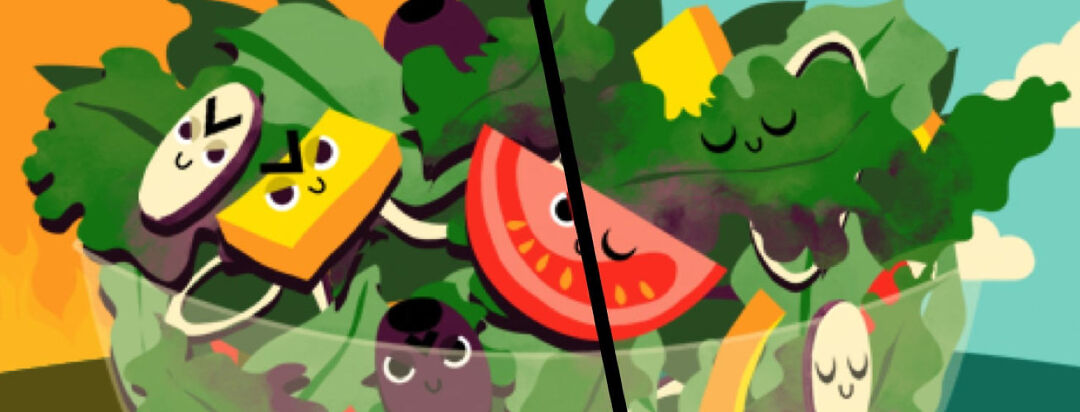Vegetables for IBS-D: Eating Without Flares
I’ve always had an unhealthy relationship with vegetables. As a child, I hated them all. As a young adult, I suddenly realized that all the girls around me were eating salads and becoming vegan, while I still enjoyed steak and fries.
Veggies good for everyone but me
That was when everyone was raving about the benefits of raw veggies, especially—the only way to eat healthily, according to them. And I tried. A lot. Unfortunately, my IBS did not agree.
Then, once I got tired of the flares, I swore off vegetables altogether. They weren’t for me. My IBS-D hated them. Or at least, so I thought.
Nowadays, I can eat many vegetables—only not in the way I tried eating them before. Below, I’ll share all the advice I have for making them work. If you also struggle with eating vegetables without triggering your IBS, I hope that some of this will work for you!
This or That
What’s more terrifying: A plate of beans or an unplanned trip with no bathroom in sight? 😂
How to safely eat vegetables with IBS-D
Cook and steam your vegetables
Cooking or steaming your vegetables is by far the most important advice I could give you. For years, I tried to eat salads and other forms of raw veggies, and they never agreed with me. Little did I know that it only took a bit of preparation to make most vegetables a lot safer for my IBS-D.
I always make sure that all my veggies are soft and well-cooked before eating them.
Peel your vegetables
Similarly, peeling can make a huge difference. I am okay with peeled eggplant, for example, and peeled zucchini is even a safe option for me. The unpeeled versions don’t work nearly as well.
Keep portions small
Those of us with IBS-D might never be able to eat a meal full of vegetables, and that’s okay. While I’m not a nutritionist, I believe that eating a small portion of vegetables with most of my meals is a lot better than eating too much at once and then avoiding veggies for months. So, just play around with quantities and see how much of each particular vegetable you can tolerate.
Mix with safe foods
Personally, I try to eat one or a maximum of two types of vegetables per meal and always mix them with safe foods. For example, I cook lots of veggies with chicken and rice, as those are very safe for me. I would never dare eat only vegetables without adding some kind of safe base, like rice, potatoes, or gluten-free pasta.
Switch up your vegetables
In my experience, eating too much of one thing can make my gut more sensitive to that food. Plus, I’m trying to get as many nutrients as possible, so switching up my veggies makes sense anyway. I also try to buy seasonally, as in-season veggies tend to be cheaper and better quality.
Categorizing your vegetables
Once you have figured out the basics for eating vegetables with your particular IBS-D, I believe that categorizing vegetables according to their safety can be very helpful. You don’t need to make an actual list. Just keep your personal categories in mind when grocery shopping and cooking.
Flare-approved vegetables
Flare-approved vegetables should be as easily digestible as white rice, or whatever your ultimate safe food is. They are okay to eat even during a flare and never cause symptoms.
Keep in mind that it’s completely possible to not have any flare-approved vegetables at all. I only have two: carrots and avocados.
Safe vegetables
Safe vegetables are the ones that work most of the time but are best avoided during an active flare. They don’t trigger symptoms per se, but still aren’t the best for an upset digestive system. I can eat my safe vegetables most days, unless my IBS-D is really acting up.
Some of my safe vegetables are:
- Zucchini (peeled)
- Beets
- Spinach
- Endives
Vegetables for good days
These are vegetables that are okay to eat on good days. When your IBS feels calm and you don’t have any digestive symptoms, they are fine. However, they need to be avoided during flare days, or when your IBS feels a bit off.
Here are mine:
- Eggplant (peeled)
- Tomatoes
- Cauliflower
- Paprika
Unsafe, but occasionally ok, vegetables
Unsafe vegetables pretty much always cause symptoms. Not necessarily terrible ones though. Whenever I eat vegetables in this category, I get a bit bloated and uncomfortable. However, I can still eat them in moderation without triggering an actual flare. My unsafe, but still eatable vegetables include:
- Green beans
- Peas
- Broccoli
Vegetables your IBS-D is allergic to
This is the category of vegetables that I would never eat, under any circumstances. They cause horrible flares, even in small quantities. Every time I’ve eaten them, my IBS reacted strongly and the flares have been no joke. This category is completely off the table for me. Thankfully, mine only includes pumpkins and orange squashes.
Categorizing vegetables can help you decide which ones are safe to eat each day, and which are best avoided in particular situations.
How does your IBS-D react to vegetables? Have you found any other ways to make them work?

Join the conversation